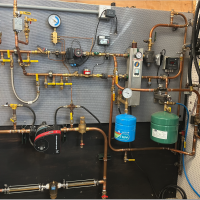Best Of
Re: New Oil Tank outside?
- Fuel gelling & tank corrosion. Corrosion is not an issue with Roth but it will still need water removed periodically
- Yes
- Remove water, more condensation in outdoor tanks
- Roth requires their outdoor kit
- Fuel gelling is the biggest concern, you can use additives or an immersion heater or both
Re: New hydronic AHU, no blower on heat call
You probably do not have a control to turn the fan on and off on heat. Simple way is a strap on aquastat which you can get at supply house.com. You need one that makes the contacts on a temp rise and breaks them on a fall very common issue. You wire the new aquastat to start the fan when the pipe gets hot.
But you could have other issues. What starts the circ pump? Do you have DHW off the boiler?
Re: What Size Recirc Pump
Hi, I'd look into demand controls instead of (or maybe in addition to) motion sensors. You very likely know thirty seconds before you plan on using hot water. If you had wireless remote buttons around the house, you could simply push one and have hot water waiting for you. The most common place to put one is on the nightstand. This way, you won't need a huge pump, or try to push the limits of what can flow through the plumbing.
Yours, Larry
Re: What Size Recirc Pump
so basically you have an electric water heater doing most of the work
What exactly are you hoping to accomplish with that size electric hw tank?
If you look at the commercial units that Rinnai builds a tankless hanging on a 50 gallon tank, a pump keeps the tank heated from the tankless for large batch draws, commercial kitchens for example
A circulator creates pressure difference as soon as it is powered, some of the ECM take 5 or do seconds to boot up. A pressure gauge on the outlet will indicate when flow starts moving
 hot_rod
hot_rod
Re: What Size Recirc Pump
To give you a direct answer: not less than 6 gpm. However. Keep in mind that it may take at least your 10 second demanded time for the pump to spin up. Maybe longer depending on the pump.
Not that there aren't ways to get this kind of near instantaneous flow response from a system; there are. Basically what you need is an accumulator, pressurised to some convenient pressure greater than the normal system pressure, connected with a fast acting solenoid valve and kept at that higher pressure by a suitable pump — doesn't have to be 6 gpm, but does have to be capable of maintaining the accumulator pressure, and should take suction from the hot water lines to keep the accumulator warm, and needs a check valve.. The accumulator is connected to the hot water storage tank inlet line, which has a suitable check valve before the connection to the tank. The accumulator is connected between the check valve and the hot water tank. The accumulator has a minimum release volume of 6 gallons (that's not the tank volume, that's the working volume between the accumulator pressure and the system pressure).
The system operation is as follows; the motion sensor trips. This opens the fast acting solenoid valve, which discharges accumulator water into the hot water tank which, in turn, discharges hot water from the tank into the water lines to the various demands (the cool water in the piping is discharged back to the house plumbing, which — because of the check valve on the inlet to the hot water tank — remains at house pressure). A pressure sensor on the accumulator activates a pump (from the house lines) which restores accumulator pressure once the fast acting solenoid valve closes after the motion sensor demand stops.
You will probably, but not certainly, need a water hammer arrestor on the hot water lines, possibly at each fixture, as the pressure spike from the accumulator and solenoid valve may otherwise create a considerable water hammer.
Slightly complex — but you are making a system demand which cannot be met in any simpler or conventional way.
Re: Biasi B10 vs Buderus …. 2024 which is most bang for the buck?
Biasi will have the best ROI given your relatively short stay in the home.
What firing rate has your contractor suggested?
Re: Radiant heating over slab on grade
Hello, Certainly others will chime in, but I'd want to know how much of a problem water coming up through the slab really is. One easy test is to tape a roughly foot square piece of plastic sheet down to the slab and leave it for a week. After that, is there any moisture on the plastic, or has the concrete darkened? If not, water isn't really a concern.
Also, do you have perimeter drainage around the slab?
Yours, Larry
Re: Radiant heating over slab on grade
Moisture doesn't hurt concrete in the least. In fact it makes it stronger. Mold growing in the concrete on the other side of a vapor barrier isn't a threat, the soil on the other side of the concrete is chock full of mold. You want to keep it on the other side of the vapor barrier from you, that's the whole point of a vapor barrier.
A dimple mat or drain board is a terrible, terrible idea. The idea that you somehow need to ventilate the space under a concrete floor is something promoted by the marketers of drainboard, it's scaremongering and ignorant of the science. They promote the idea of a "drying space" under the floor. If there is moisture under the floor you want it staying there, you don't want it drying into your living space.
All of the above assumes we're talking about moisture coming out of the soil and into the concrete through capillary action, also known as "rising damp." If there is liquid water intrusion, it needs to be dealt with by giving the water a place to go and disposing of it. A drainboard is a bandaid patch for liquid water, it conceals it and doesn't solve the underlying problem.
Re: Plant Based Glycol
A bit to add to @GGross 's comment. Propylene glycol is, as he says, generally recognized as safe. Ethylene glycol, on the other hand (used in combustion engine cooling systems) is not; in fact, it's quite toxic.
So step one here is to realise that "glycol" is not a helpful chemical term. You need to specify which of those two common glycols you mean (there are others as well).
Then step two is to recognize that propylene glycol — we are going to assume that that is what you intend to use; at least I hope it is — is a chemical name, and what it is made from has no bearing on its chemical properties. As it happens, from the manufacturing standpoint, it's a good deal easier to make starting with one of the product streams from refining crude oil. Most of the work has already been done naturally. However, it can be made with varying difficulty from any saturated hydrocarbon. It can also be made, but with censurably greater difficulty, from some unsaturated fats, including oils from crop plants (primarily soybeans). This is more difficult chemically, and a much more intensive use of land and water (it takes a lot of land and water to grow crops than it does to run an oil well!). This it will be more expensive.
The end result chemical is exactly the same in either case.
Re: Random Backflow Preventor + Shutoff Valve??
The check valve will either leak out the vent or not pass water if there is something wrong with it. The prv itself usual fails by not sealing all the way and the pressure in your system slowly creeps up. You could replace all of it, you could replace none of it, you could rebuild the prv you currently have. I like that callefi one, it does auto fast fill even though the one I have had the check valve crust itself shut.




